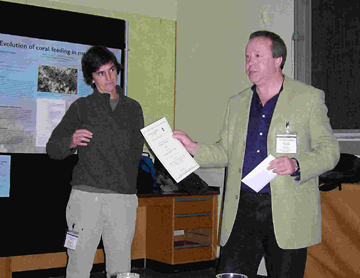

The Annual Award
Winner , Dr Regina da Cunha of the Autonomous University of Madrid
and the Museum of Natural Sciences, describes her work (see also the
Forum abstract).
| The
idea of working with Cape Verde Conus come out eight years
ago by suggestion of Carlos Afonso, a biologist and enthusiastic
shell collector. The extreme diversity exhibited by this genus
in these oceanic islands, which represents about 10% of the worldwide
diversity, attracted the attention of several malacologists. Dr.
Emilio Rolán performed a thorough analysis of this group
based on several morphological characters, founding the existence
of two major groups that correspond to shell size. Yet, no phylogeographic
structure was found. During my doctoral research in the Natural Sciences Museum of Madrid under the supervision of Dr. Rafael Zardoya I focused on phylogenetic relationships of endemic populations of Conus from the Cape Verde Islands. During three field trips to the islands of Boavista, Maio, Santiago, and Sal we collected 41 out of the 49 endemic species of Conus. Molecular data combined with geometric morphometric analysis were used to address fundamental questions in evolutionary biology regarding marine speciation.Molecular phylogenetic analyses revealed the existence of two major groups that correspond to shell size, the “large” and “small” shelled clades, which was in agreement with previous results based on morphological characters. |
 |
| FIG 1: The President, Professor Mark Davies, presents the Annual Award to Dr Regina da Cunha at the Molluscan Forum in November 2009 at the Natural History Museum. |
A biogeographic pattern was also found with species from Sal and São Vicente forming monophyletic island assemblages whereas species from Maio and Boavista grouped together. This pattern showed the direct effect of the reduced dispersal ability of nonplanktonic larvae into the diversification process of Cape Verde Conus. The deep channels that surround Sal and São Vicente prevented the dispersal of these non-pelagic larvae. A 100m-depth channel separating Maio and Boavista allowed communication and gene flow during the Plio-Pleistocene low sea level stages, which explains the observed phylogeographic patterns. A molecular clock analysis indicated a double colonization of the archipelago at 16.5 and 4.6 million years ago million years by the ancestors of “small” and “large” shelled clades, respectively.
I have also analyzed the influence of historical processes, as the effect of eustatic sea-level changes, on diversification of the “large” shelled Conus. Molecular analyses within this clade showed the existence of three monophyletic groups that do not correspond to current species classification based on shell banding patterns. Moreover, “large” shelled species replicated the biogeographical pattern of the “small” shelled clade 12 million years later showing the important role of determinism in the diversification of Cape Verde Conus.
From this doctoral project three papers were published:
Cunha et al.,
2005 Systematic Biology;
Cunha et al., 2008 Molecular Ecology;
Cunha et al., 2009 BMC Evolutionary Biology.
I continue very
much interested in integrating phylogeographic and molecular approaches
to infer evolutionary processes that explain current patterns of genetic
diversity in populations of invertebrate marine organisms particularly
on isolated oceanic islands. Oceanic archipelagos are renowned as
biodiversity “hot spots” because they support a remarkable
number of endemic species and are therefore excellent model systems
to study speciation processes.
Future studies will focus on using molecular data to determine if
Conus guanche from the Canary Islands represents a cryptic
species complex due to the existence of some morphological differences
between populations, and the low dispersal abilities of its lecithotrophic
larvae. Other studies include assessing the role of larval development
and sea level changes in the diversification of the marine gastropods
belonging to the genera Volvarina and Fissurella from
the Cape Verde archipelago.
FIG 2: Systematic
Biology 54(4) Cover